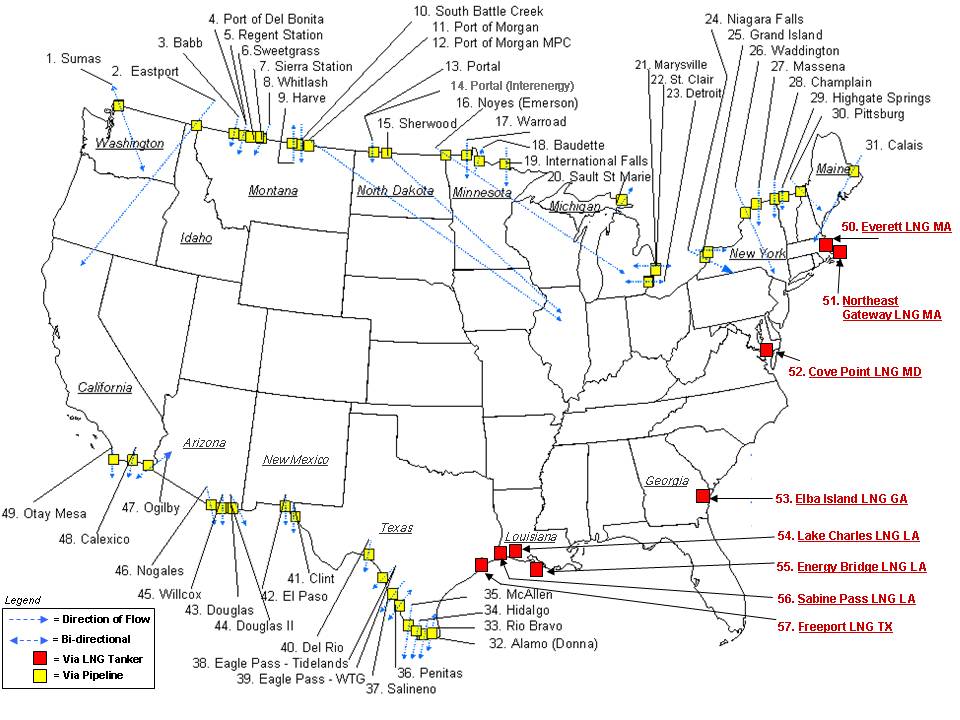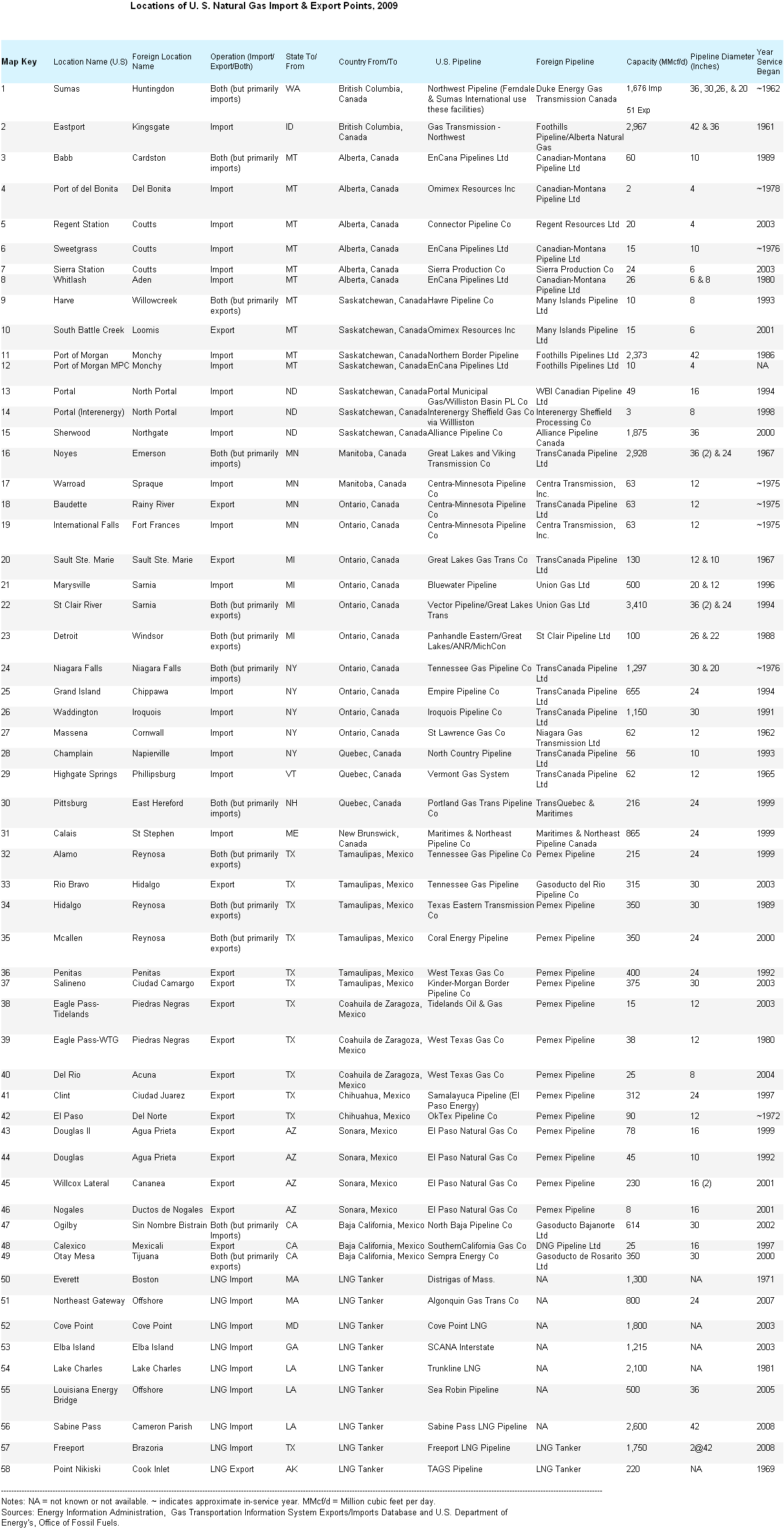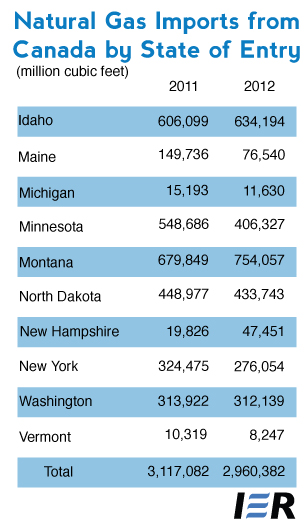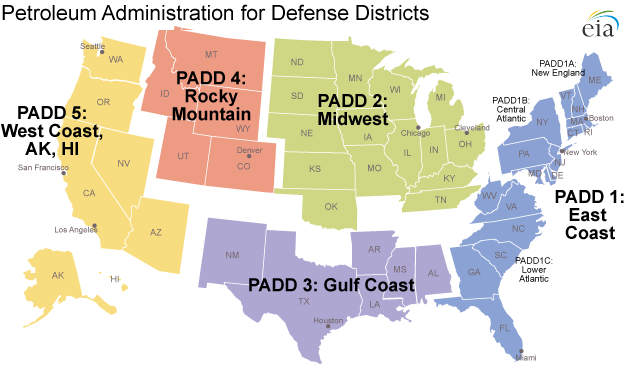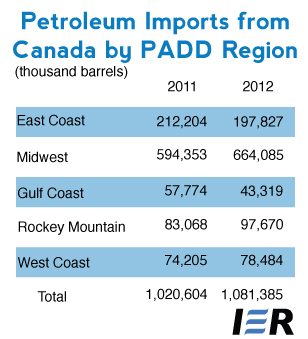The United States imports and exports oil and natural gas to and from Canada. Most of these fuels are transported by pipeline—the least expensive and safest transport means to move these fuels. Natural gas imports from Canada total around 3 trillion cubic feet a year and petroleum imports total around 1 billion barrels a year. Without these imports, Americans would need to import more oil from overseas at a greater cost to our economy. Let’s take a look at who is benefiting the most from these imports.
Natural Gas Imports from Canada
Natural gas is imported from Canada by pipeline and every state that shares a land border with Canada has at least one pipeline crossing. The states serving as a point of entry for natural gas imported from Canada are: Idaho, Maine, Michigan, Minnesota, Montana, North Dakota, New Hampshire, New York, Washington, and Vermont. The 31 points of entry between Canada and the United States for natural gas are indicated on the map below and detailed in the table below.
U.S. Natural Gas Import/Export Locations, as of 2008
Four of the states through which Canadian natural gas moves–Montana, Idaho, North Dakota, and Minnesota– account for about 75 percent of all the natural gas brought into the United States via pipeline from Canada. These states consume very little of the natural gas themselves, transferring it to other states with much higher natural gas demand. For example, Canadian natural gas entering through the states of Washington and Idaho supplies about one-quarter of the natural gas demand in California—a state that gets over 55 percent of its electricity generation from natural gas. Natural gas is also used heavily in California’s buildings sector and for industrial uses. The state of Washington most likely gets all its natural gas demand from Canada.
Source: Energy Information Administration, http://www.eia.gov/dnav/ng/ng_move_poe1_a_EPG0_IRP_Mmcf_a.htm
Montana serves as a point of entry for Canadian natural gas and pipes most of the Canadian gas it receives to North Dakota, who in turn pipes it to Minnesota and South Dakota. Both Wisconsin and Illinois benefit from Canadian natural gas coming by pipeline from the Dakotas and Minnesota. Illinois uses three-quarters of its natural gas supplies in the residential and commercial sectors, heating homes and offices, while Wisconsin uses slightly less of a percentage in those sectors (about two-thirds).
On the east coast, Vermont is entirely dependent on natural gas from Canada to meet its demand. Interestingly, Vermont was also the first state to ban hydraulic fracturing, which combined with horizontal drilling in shale structures, has made the U.S. the largest producer of natural gas in the world. Maine gets its natural gas supplies mainly from Canada and sends a large amount of natural gas to New Hampshire, who uses it to supply its own demand and also pipes supplies to Massachusetts. Massachusetts also receives domestic natural gas shipments and imports liquefied natural gas (LNG) from Trinidad and Tobago and Yemen via its LNG terminals in Everett, Massachusetts, and its Northeast Gateway terminal. Massachusetts’ demand for natural gas is relatively high among U.S. states, using its natural gas supplies mostly in the buildings sector to meet residential and commercial demand, but also to generate electricity and for industrial uses. New York also receives natural gas imports from Canada, but receives a large amount of its natural gas from the Marcellus shale in Pennsylvania. Seventy percent of New York’s demand is used in the buildings sector.
Oil and Petroleum Product Imports from Canada
The majority of the crude oil imported into the United States from Canada comes via pipeline. There are, however, Canadian crude oil and petroleum products arriving by ship to the East, West, and Gulf coasts and more recently, shipments to U.S. refineries by train, resulting from pipelines reaching near capacity and delays in approving the Keystone pipeline by the Obama Administration.
Oil and petroleum product data are categorized within 5 Petroleum Administration for Defense Districts (PADDs) in the United States, which are geographic aggregations of the 50 States and the District of Columbia: PADD 1 is the East Coast, PADD 2 the Midwest, PADD 3 the Gulf Coast, PADD 4 the Rocky Mountain Region, and PADD 5 the West Coast. Due to its large population, PADD 1 is further divided into sub-PADDs, with PADD 1A as New England, PADD 1B the Central Atlantic States, and PADD 1C comprising the Lower Atlantic States. (See map below.) The PADDs were defined during World War II when the Petroleum Administration for War, established by an Executive order in 1942, used these five districts to ration gasoline. Although that Administration was abolished in 1946, Congress passed the Defense Production Act of 1950, which created the Petroleum Administration for Defense using these five districts. The PADDs help users of petroleum data assess regional petroleum product supplies.
Source: Energy Information Administration, http://www.eia.gov/todayinenergy/detail.cfm?id=4890&src=email
Canadian oil imports from Canada into the Midwest and Rocky Mountain regions (PADDs II and IV) arrive via pipeline. The other PADDs also receive Canadian petroleum imports via ship. And more recently, rail is being used to move oil sands from Alberta, Canada to the east and Gulf coasts of the United States. An estimated 120,000 barrels of oil per day are being moved by train to those regions. That number could reach 200,000 barrels per day by the end of the year when several rail terminals are expected to be completed. While rail costs are double pipeline tariffs, the lower cost Canadian oil make it profitable to use rail. Last year Canadian light oil traded as low as $68 per barrel and heavy oil at $48 per barrel, while refiners on the U.S. Gulf Coast and northeast were paying overseas prices for their heavy oil feedstock of around $110 per barrel. The large differential made room for the higher priced rail tariff, particularly since pipeline capacity is limited from Canada into the United States. However, that price differential is no longer as great due partly to the increase in U.S. refinery demand for Canadian oil, which has lifted its price and made higher cost rail less competitive.
Source: Energy Information Administration, http://www.eia.gov/dnav/pet/pet_move_impcp_a2_r10_ep00_ip0_mbbl_a.htm
While the Midwest receives the largest amount of Canadian petroleum imports, some of those imports are piped to other regions, particularly to the Gulf coast.
Conclusion
Petroleum imports from Canada to the United States increased by almost 7 percent in 2012 from 2011 levels. These imports are mainly moved via pipeline to the United States, though the ports on the U.S. coasts also receive Canadian oil imports by ship, and more recently petroleum has been shipped by rail. Clearly without these imports, the east coast and Midwest would suffer the most in terms of limited petroleum supplies.
All of our natural gas imports from Canada are piped into 31 entry points in the United States. Natural gas from Canada helps to meet demand in many of the northern U.S. states that use it to heat homes and to generate electricity.
Since pipeline is the least expensive and safest transportation mode, it would be beneficial to the United States to increase that capacity in order to access Canadian oil reserves— the third largest in the world at 175 billion barrels.


